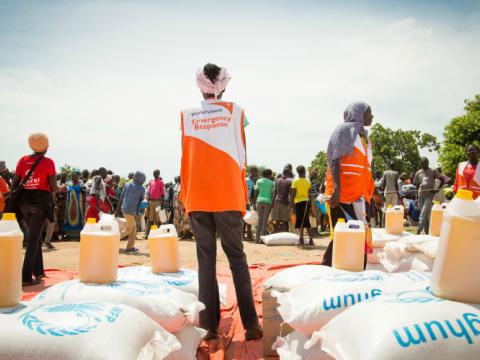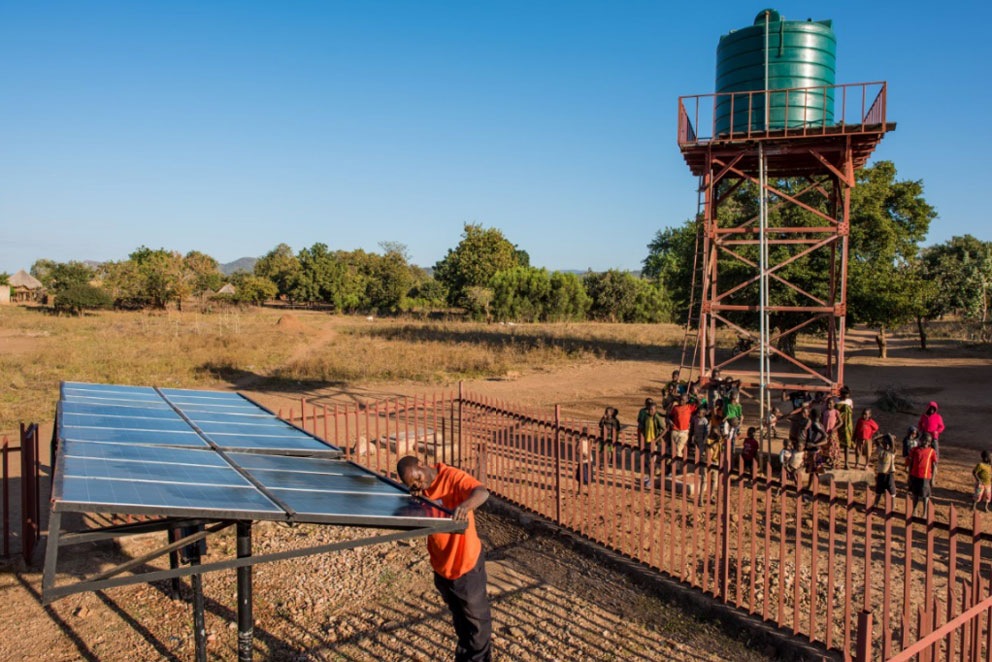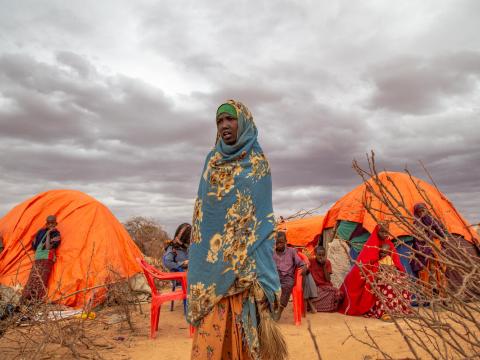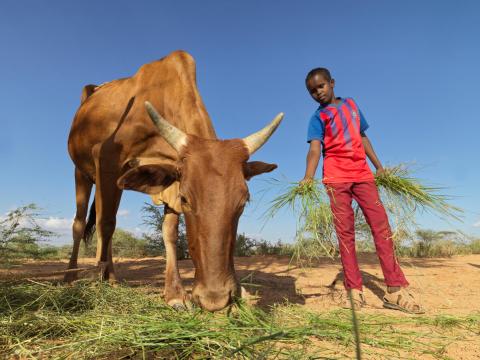
The three biggest humanitarian challenges facing the world right now… and what to do about them
Emergency Communications Director James East explains that the threats to the world's most vulnerable people aren't impossible to prevent, but that time is running out
15 January, 2024
In 2024, no-one wants to see a repeat of the humanitarian challenges of last year when new records were broken: more people than ever in need; more money required; more crises to respond to.
Last year a record 362 million people needed humanitarian help – up a massive 30% on the previous year. However, only $20 billion of the $57 billion needed to help was given; no-where near enough at a time when crises were as complex as the world has ever faced. But the work of humanitarians is not just about providing life-saving Band-Aid solutions. It’s also about bringing hope to those in pain that life can be better. Humanitarians too cannot function without that hope, otherwise all that is left is despair.
As the poet theologian Samuel Taylor Coleridge wrote:
Work without hope draws nectar in a sieve,
And hope without an object cannot live.
Here are three big humanitarian challenges facing the world today and one key action for each, that can bring that hope.

Conflict
One can barely turn on the TV without seeing the depressing news of missile strikes, gun battles and urban destruction. In Gaza, the West Bank and Israel more than 23,000 people are now dead, most of them women and children. The conflict is creating division and anger across the world.
In Europe, next month (February) marks the second year of the Russia-Ukraine war, with no end in sight. It’s also almost a year too since the Türkiye-Syria earthquake killed 55,000 people, much of the destruction happening in a conflict zone in northwest Syria inaccessible to international aid workers.
In Sudan, civil war has created the largest displacement crisis in the world – an exodus almost invisible to most of us. More than 6.7 million Sudanese are now scattered across East Africa, or desperately trying to avoid armed groups at home who are killing, raping and maiming with impunity. In West Africa, widespread militant insurgency means large areas of the region are impoverished, insecure and beyond the reach of humanitarians.  Elsewhere, civil wars, inter-ethnic conflicts, gang violence, authoritarianism and oppression are widespread, in Venezuela, Haiti, Myanmar, Syria, Yemen and beyond. Forced displacement is always conflict’s bedfellow. There are now an estimated 110 million people forcibly displaced by conflict and persecution. Families caught in conflict chaos have to escape the violence and find new lives, often in other countries. New economies of exploitation emerge to service their desperation.
Elsewhere, civil wars, inter-ethnic conflicts, gang violence, authoritarianism and oppression are widespread, in Venezuela, Haiti, Myanmar, Syria, Yemen and beyond. Forced displacement is always conflict’s bedfellow. There are now an estimated 110 million people forcibly displaced by conflict and persecution. Families caught in conflict chaos have to escape the violence and find new lives, often in other countries. New economies of exploitation emerge to service their desperation.
In central America, gangs control the 60-mile Darién Gap, a jungle choke point for those fleeing violence across Latin America. Hundreds of thousands of people have transited through it on their way to the US border at risk of being robbed, assaulted or worse. It's a similar story on the Mediterranean. Human smugglers control the deadly sea route to Europe exploiting those fleeing conflicts in Africa, the Middle East and South Asia.
The mass movement and inflow of migrants and refugees is now not only a politically divisive issue for Western democracies but also has the potential to fire up ethnic, religious and economic tensions in developing countries themselves grappling with migrant flows.
Solution: Peacebuilding
Over the past 15 years the world has become less peaceful. The economic impact of violence on the global economy amounts to an estimated $17.5 trillion – or $2,200 per person. And yet the success of the UN in brokering peace, so instrumental to ending conflicts in East Timor (1999), Sierra Leone (1999), Angola (2002), Sudan (2005), and Nepal (2006), has declined in recent years. Key donors like the UK and Sweden have also slashed peacebuilding funding.
It’s well past time to put peacebuilding – not just UN peacekeeping – back at the heart of UN humanitarian efforts. That means more active monitoring for potential conflicts and sending in UN conflict prevention teams to broker solutions before things flare up; supporting and funding community peacebuilding efforts to give local leaders the skills to de-escalate tensions; and empowering UN leaders, as in the past, to take a more personalised and less institutionalised approach to engaging with key belligerents.
One of the ways World Vision contributes to peacebuilding is we run peace clubs in places like South Sudan and works with faith leaders to foster peace between religious groups.

But much more needs to be done to support peacebuilding at the global, national and community level to create the conditions for peace. Without proactive, as opposed to reactive, peacebuilding the world will continue to be become more dangerous and refugee flows will continue.
Climate change
Climate monitoring organisations have just declared last year the hottest on record, capping 12 months that saw record sea temperatures, record ice loss on the Southern Pole, and accelerating sea-level rise.
Vast regions of the world are now experiencing the impacts of climate change. This is most obvious in the Horn of Africa where five years of continuous drought were followed by heavy rains and flooding. Millions of animals in Somalia, Ethiopia, Kenya and South Sudan died, wrecking the frugal livelihoods of nomadic families. Many vitally needed crops withered. Even where some crops did grow, they were then often drowned by flash floods.

Temperature increases also super-charged storms. In Libya, Storm Daniel downpours overwhelmed dams that then collapsed, killing over 4,000 people in the resulting deluge. In Myanmar and Bangladesh hundreds of people were killed by cyclone Mocha. Packing wind speeds of 280 km/h (175 mph) it was the most powerful storm on record for the region. In Canada, forest fires caused massive destruction, while a firestorm in Hawaii moved so fast 100 people died, unable to outrun its advance.
Climate change is now happening so quickly that vulnerable communities barely have time to recover before facing the next disaster. Small island states are on the frontlines. Islanders are grappling with land lost to sea-level rise, saltwater corruption of drinking water and farmland, coral bleaching of their fisheries and ever more powerful cyclones. By the second half of this century some islands could become uninhabitable.
Population displacement is increasingly likely. Between 2016 and 2021, weather-related disasters displaced 43.1 million children. Floods and storms accounted for 95% of them with drought driving 1.3 million internal displacements, many in Somalia. 20,000 children a day are on average being forced to move by climate impacts.
Climate change is a threat multiplier: It destroys livelihoods, forces families to move, creates conflict over scarce resources, and exposes children to increased exploitation.
Solution: Transition to clean and renewable energy
There is a raft of actions that must be taken to limit, prepare for, and adapt to climate change. But central to everything is the commitment to limit global warming to 1.5 degrees Celsius by 2100, set as a target at the 2015 Paris Agreement. Breaching this will push the world across tipping points that will trigger irreversible ice sheet melting and sea level rise. The latest data shows there is now a risk that the 1.5C threshold will be breached as early as 2029.
There is now a very narrow window of opportunity to take drastic action. This is why last month’s COP 28 called for the transitioning away from fossil fuels, in ways that are equitable and just for the developing world, in order to rapidly reduce carbon emissions from coal, oil and gas. The commitment to do this was the central agreement at the UN climate meeting. Just-released climate data for 2023 showing a record-breaking global temperature increase is proof that that there is not a moment to lose.

Hunger
Getting to zero hunger by 2030 was once considered an achievable global target. But things are now well off track. Conflict and climate change, the economic aftershocks of COVID and a cost-of-living crisis driven by war in Ukraine, are creating a rapidly worsening global hunger crisis. Children almost everywhere are going without food.
 The number of people facing extreme hunger has nearly doubled since 2019, rising to 258 million in 58 countries. Thirty-five million people in 39 countries are on the brink of famine approximately half of them children. Nearly one-third of the world’s people (2.4 billion people) do not have enough to eat.
The number of people facing extreme hunger has nearly doubled since 2019, rising to 258 million in 58 countries. Thirty-five million people in 39 countries are on the brink of famine approximately half of them children. Nearly one-third of the world’s people (2.4 billion people) do not have enough to eat.
The World Food Programme is also struggling to feed the most vulnerable, not just because of the increase in numbers but also due to the rising cost of food. Its funding does not stretch as far and this has forced severe ration and cash cuts in many places, including for refugees.
The lasting impact of a poor diet is not as obvious as the physical manifestation of starvation, but the consequences for children are extremely damaging. Malnourished children, have a higher risk of death from common childhood illness such as diarrhoea, pneumonia, and malaria. Nutrition-related factors contribute to about 45% of deaths in children under-5 years of age. Undernourished children suffer developmentally and can be physically and mentally harmed for life. And likewise, if new mothers are undernourished, they need nutrition support to ensure their babies get off to a good start.
Solution: School lunches
 The global hunger crisis is so threatening to child wellbeing that World Vision’s recently launched global campaign ‘ENOUGH’ is focused on the policy actions needed to end hunger, while our staff around the globe are doing all they can to meet the nutrition needs of tens of millions of people.
The global hunger crisis is so threatening to child wellbeing that World Vision’s recently launched global campaign ‘ENOUGH’ is focused on the policy actions needed to end hunger, while our staff around the globe are doing all they can to meet the nutrition needs of tens of millions of people.
Addressing climate change and reducing conflict are both key ingredients to defeating hunger. But one immediate and practical solution is the funding and implementation of school lunch programmes. Ensuring vulnerable children get at least one decent meal a day at school means girls and boys stay healthy, get an education and avoid having to beg, work or be forced into sexual exploitation in return for money or food.
Last year, World Vision and our partners reached over 1 million children with school meals in 16 countries. We are calling for and support government roll outs of school feeding programmes. These need to be massively scaled up in 2024.
The humanitarian challenges facing the world are enormous. We must hold fast onto hope in 2024. We all need to be peacemakers. We all need to do our bit for the climate. And we must make sure no child dies of hunger when so many have so much.
To learn more about World Vision's work to address disasters click here
To learn more about the emergencies that World Vision is responding by clicking here
James East is World Vision's Director of Emergency Communications.


